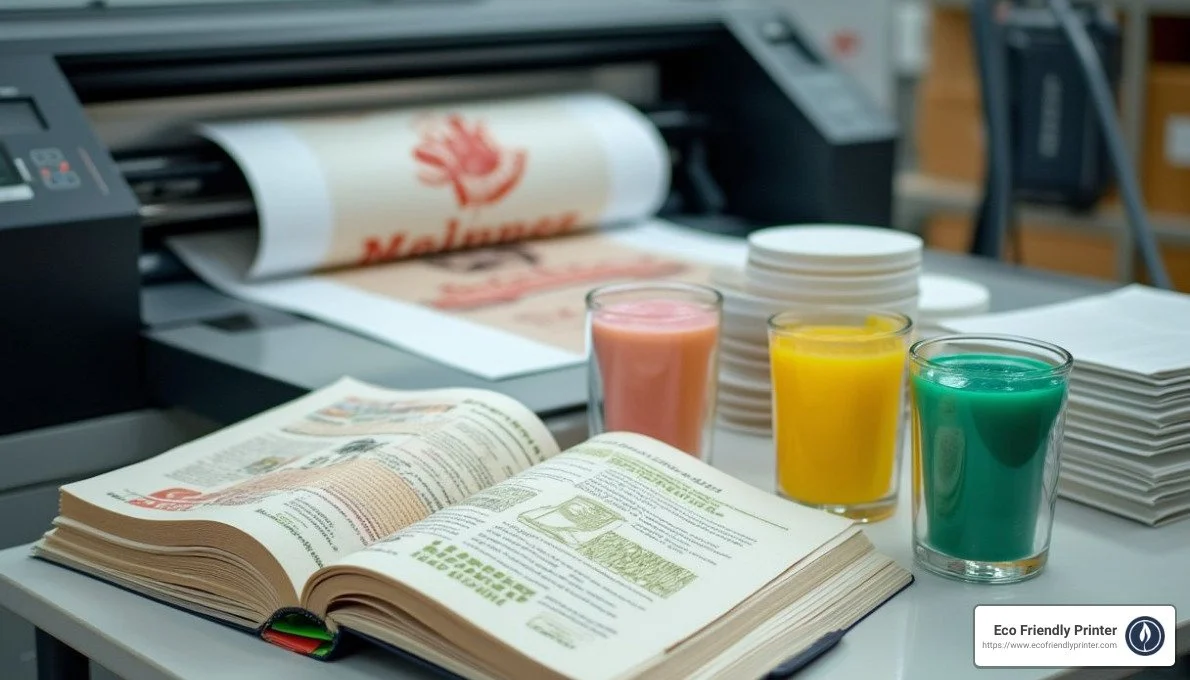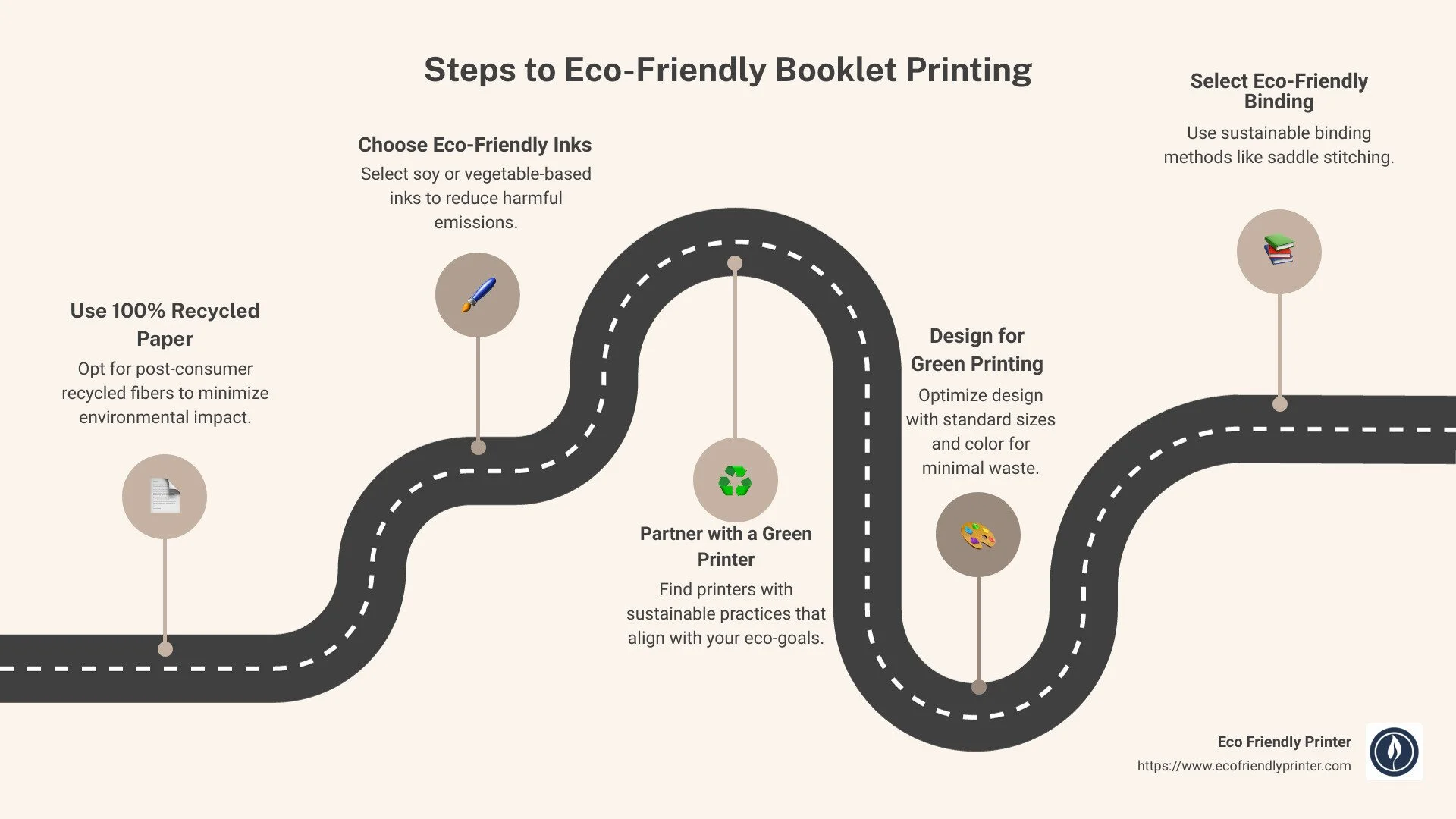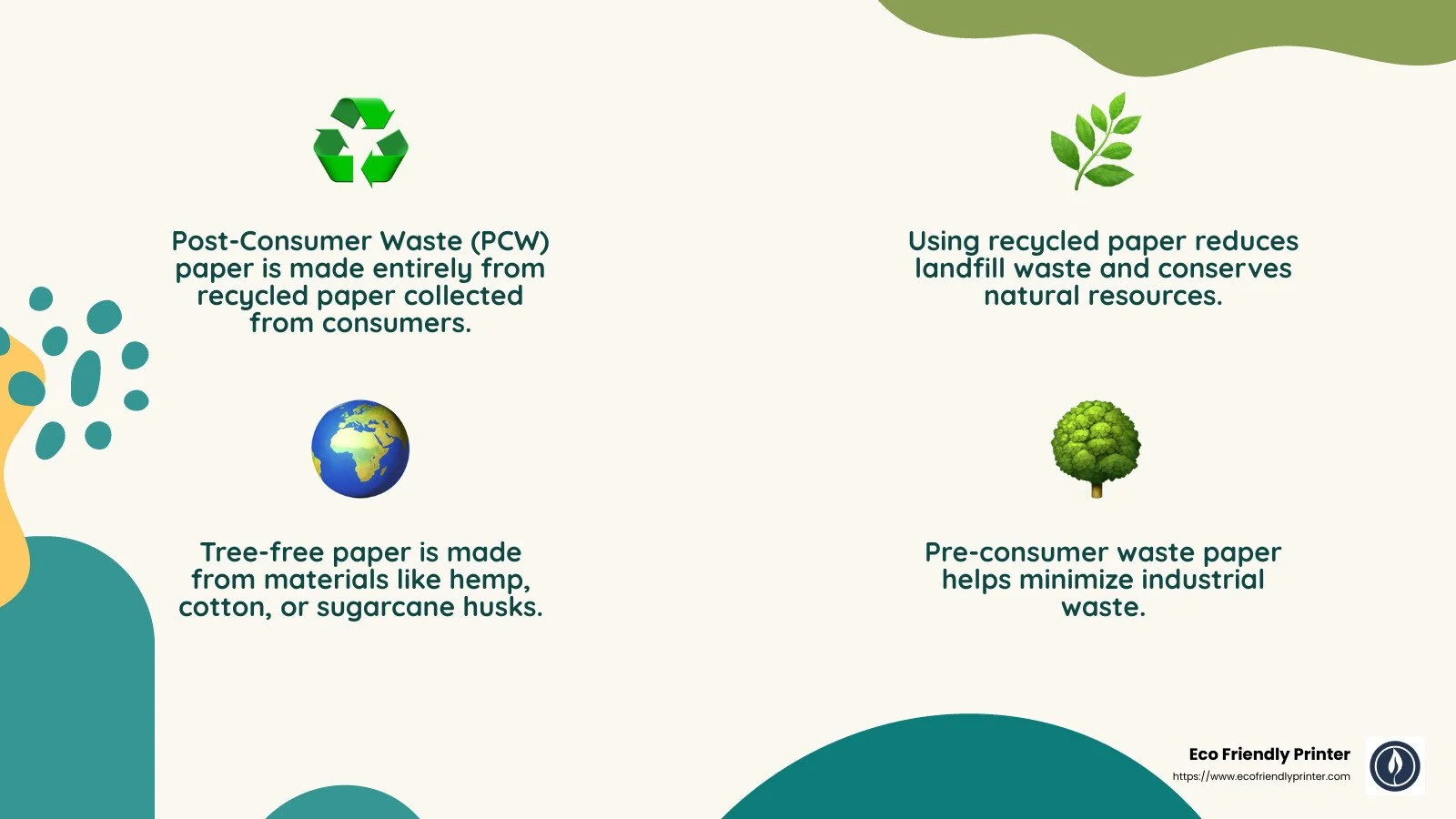Creating Eco-Friendly Booklets: A How-To on Recycled Printing
Recycled booklet printing is a straightforward way to combine sustainability with high-quality print production. It involves using recycled materials and eco-friendly inks to produce booklets that meet both environmental standards and your business needs.
Use 100% recycled paper: Opt for post-consumer recycled fibers.
Choose eco-friendly inks: Soy or vegetable-based inks reduce emissions.
Partner with a green printer: Ensure their practices align with your eco-goals.
By embracing recycled booklet printing, you're taking a step toward eco-friendly practices, helping reduce waste, and minimizing your company's carbon footprint.
As Greg Barber, founder of Eco Friendly Printer, I've dedicated my career to revolutionizing sustainable printing. With over three decades of expertise in recycled booklet printing, I strive to guide businesses in making environmentally conscious choices that align with their sustainability goals.
Understanding Recycled Booklet Printing
What is Recycled Booklet Printing?
Recycled booklet printing is the process of creating booklets using recycled materials and eco-friendly methods. This approach not only helps in reducing environmental impact but also aligns with sustainable business practices. By opting for recycled booklet printing, businesses can showcase their commitment to environmental stewardship while still producing high-quality printed materials.
Types of Recycled Paper
When it comes to recycled booklet printing, the type of paper used is crucial. There are several options available:
Post-Consumer Waste (PCW) Paper: This type of paper is made entirely from recycled paper collected from consumers. It's an excellent choice for reducing landfill waste and conserving natural resources.
Pre-Consumer Waste Paper: This paper is made from manufacturing waste that never reached the consumer. While it doesn't contribute to landfill reduction as much as PCW, it still helps minimize industrial waste.
Tree-Free Paper: An innovative alternative, tree-free paper is made from materials like hemp, cotton, or sugarcane husks. Although more expensive, it's an excellent way to avoid deforestation.
Eco-Friendly Inks and Chemicals
Choosing the right inks and chemicals is another critical aspect of recycled booklet printing. Traditional inks can be harmful to the environment, but eco-friendly alternatives are available:
Soy-Based Inks: These inks are derived from soybeans and are a popular choice for sustainable printing. They are biodegradable and produce less volatile organic compounds (VOCs), making them less harmful to the environment.
Vegetable-Based Inks: Similar to soy-based inks, these are made from renewable resources like linseed or cottonseed oil. They are considered more sustainable than petroleum-based inks.
Low VOC Solvents: Using low VOC solvents in the printing process reduces the emission of harmful chemicals into the atmosphere. This choice is essential for maintaining air quality and protecting the environment.
By understanding and implementing these eco-friendly practices, businesses can significantly reduce their environmental impact while maintaining the quality and effectiveness of their printed materials.
Steps to Create Eco-Friendly Booklets
Designing for Green Printing
Creating eco-friendly booklets starts with smart design choices. Designing for green printing involves optimizing your design to minimize waste and energy use. Here are some tips:
Standard Sizes: Stick to standard paper sizes like A4 or A5. This reduces offcuts and waste, making the process more efficient.
Color Optimization: Use a two-color scheme instead of full color. This not only saves ink but can also create an neat design when done right.
Combining Jobs: If possible, combine multiple print jobs. This can optimize paper and ink usage, reducing overall waste.
Choosing the Right Paper
The choice of paper is crucial in eco-friendly printing. Look for papers that are FSC certified, which ensures responsible forest management and sustainability. Consider these options:
100% Recycled Paper: This is the most sustainable choice, particularly post-consumer waste (PCW) paper, which is made from recycled consumer paper.
Green Seal Certified Paper: This certification guarantees that the paper meets stringent environmental criteria, including recycled content and reduced chemical use.
Printing Process
Choosing the right printing process is key to minimizing environmental impact:
Digital Printing: Ideal for small runs and quick turnarounds. It uses less paper and ink, making it a more eco-friendly option for short print jobs.
Offset Printing: Suitable for larger print runs. When done with eco-friendly practices, it can be very efficient. Look for printers that use eco-friendly inks and practices.
Eco-Friendly Printers: Partner with printers committed to sustainable practices. They should offer options like soy-based inks and low VOC solvents.
Binding Methods
Binding is the final step in creating a booklet, and choosing an eco-friendly method is important:
Saddle Stitching: This is a simple and eco-friendly binding method where the booklet is stapled along the spine. It works well for smaller booklets.
Perfect Binding: Suitable for larger booklets, this method uses glue to bind the pages. Opt for eco-friendly adhesives to maintain sustainability.
Eco-Friendly Binding: Some printers offer innovative binding solutions that reduce the use of harmful chemicals and materials.
By following these steps, you can create eco-friendly booklets that not only look professional but also align with sustainable values. This approach helps reduce environmental impact and supports a greener planet.
Benefits of Recycled Booklet Printing
Environmental Impact
Choosing recycled booklet printing can make a significant positive impact on the environment. Here’s how:
Tree Conservation: By using 100% recycled paper, we save trees from being cut down. Each ton of recycled paper can save 17 trees, which is crucial in reducing deforestation.
Reduced Emissions: Recycled paper production uses less energy and water, leading to lower carbon emissions compared to traditional paper. This helps combat climate change by reducing greenhouse gases.
Waste Reduction: Recycling paper reduces the amount of waste sent to landfills. Paper can be recycled 4 to 5 times, decreasing the need for new resources.
Cost Savings
Eco-friendly printing is not just about protecting the environment—it’s also about saving money:
Reduced Energy Use: The process of recycling paper uses up to 50% less energy than producing new paper. This translates to cost savings in production.
Lower Material Costs: Recycled materials can often be cheaper than virgin materials, especially when purchased in bulk. This reduces overall printing costs.
Long-Term Savings: Investing in sustainable practices can lead to long-term financial benefits. As eco-friendly technologies advance, costs continue to decrease, making green printing a smart economic choice.
Enhancing Brand Image
Adopting eco-friendly practices can boost your brand’s reputation:
Consumer Perception: Today's consumers value sustainability. By using recycled booklet printing, you show a commitment to environmental responsibility, which can improve customer loyalty.
Corporate Responsibility: Demonstrating corporate social responsibility through sustainable practices sets your company apart as a leader in environmental stewardship.
Market Differentiation: Companies that prioritize eco-friendliness can differentiate themselves in the market. This can attract environmentally conscious customers who are willing to pay more for sustainable products.
By embracing recycled booklet printing, businesses not only contribute to a healthier planet but also enjoy cost savings and an improved brand image. This sustainable approach is a win-win for both the environment and your business.
Frequently Asked Questions about Recycled Booklet Printing
How Do I Print a Folded Booklet?
Printing a folded booklet can seem tricky, but it's easier than you might think. Here's a simple guide:
Choose Your Layout: Decide if you want a side-fold or a top-fold booklet. Most booklets are side-folded, which means they open like a book.
Set Up Your Document: Use a design software that supports booklet layouts. You'll want to set up your pages in a way that allows for duplex printing (printing on both sides of the paper).
Print in the Right Order: This is where imposition comes in. Imposition is the process of arranging your pages so that when printed and folded, they appear in the correct order. This often involves printing pages out of numerical order.
Test Your Layout: Before doing a full print run, print a test copy. This helps ensure everything lines up correctly.
Choose Binding: Saddle stitching is a popular and eco-friendly choice for binding folded booklets. It involves stitching the pages together along the fold.
By following these steps, you'll create a professional-looking folded booklet with ease.
Is It More Expensive to Print on Recycled Paper?
A common concern is whether printing on recycled paper costs more than using traditional paper. Here's the scoop:
Cost Comparison: The price of recycled paper has decreased over the years, often matching or even being lower than non-recycled options. This is due to increased demand and improved recycling technologies.
Market Trends: As sustainability becomes more critical, many companies are choosing recycled materials, driving down costs further. This means you can often find recycled paper at competitive prices.
Additional Steps: While there might be additional steps in sourcing recycled paper, the overall cost impact is minimal. Plus, any slight cost increase is usually offset by the environmental benefits and potential for improved brand image.
So, while there might be a perception that recycled paper is more expensive, the reality is that it’s often comparable in cost—and the benefits far outweigh any slight price differences.
What is Preimposed Booklet Printing?
Preimposed booklet printing refers to the arrangement of pages before printing to ensure they appear in the correct order once printed and folded. Here's how it works:
Imposition Basics: Imposition involves setting up your pages in a specific sequence. This ensures that when the sheets are folded and bound, the pages flow in the right order.
Page Arrangement: For example, in an 8-page booklet, page 1 might be printed next to page 8, and page 2 next to page 7. This allows the booklet to be folded and read correctly.
Printing Order: Preimposed printing eliminates the need for manual page sorting after printing, saving time and reducing errors.
Understanding preimposition is crucial for efficient booklet printing, ensuring your project is both professional and seamless.
Conclusion
At Eco Friendly Printer, we believe in making sustainable printing accessible and affordable for everyone. Our mission is simple: to lead the industry with eco-friendly solutions that don't compromise on quality or cost. We’re here to guide you every step of the way, ensuring your transition to green printing is smooth and successful.
Sustainable Printing Solutions
Our commitment to sustainability is reflected in every aspect of our service. From using 100% recycled paper to employing soy-based inks, we prioritize eco-friendly practices that benefit both the planet and your business. Our recycled booklet printing services are crafted to deliver high-quality results while reducing your environmental footprint.
Professional Guidance
Navigating eco-friendly printing can seem daunting, but it doesn’t have to be. We provide expert guidance to help you make the best choices for your printing projects. Whether you're a small business or a large corporation, our team is dedicated to offering personalized support that meets your unique needs. We ensure your projects not only meet but exceed your expectations in both sustainability and quality.
By choosing Eco Friendly Printer, you're not just selecting a service; you're joining a community committed to environmental stewardship and innovation. Together, we can create a more sustainable future, one printed page at a time.



